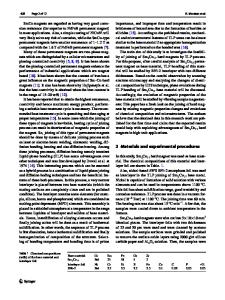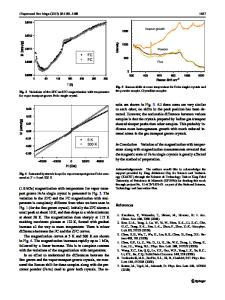Magnetic properties of Tb 2 (Fe,Si) 17 single crystals
- PDF / 126,788 Bytes
- 4 Pages / 612 x 792 pts (letter) Page_size
- 75 Downloads / 342 Views
MATERIALS RESEARCH
Welcome
Comments
Help
RAPID COMMUNICATIONS The purpose of this Rapid Communications section is to provide accelerated publication of important new results in the fields regularly covered by Journal of Materials Research. Rapid Communications cannot exceed four printed pages in length, including space allowed for title, figures, tables, references, and an abstract limited to about 100 words.
Magnetic properties of Tb2(Fe,Si)17 single crystals Y.X. Li, S.X. Gao, J. Du, C.C. Tang, C. Cai, G.H. Wu, and W.S. Zhan State Key Laboratory for Magnetism, Institute of Physics and Center for Condensed Matter Physics, Chinese Academy of Sciences, Beijing 100080, People’s Republic of China (Received 12 September 1997; accepted 19 April 1999)
The magnetic properties of single-crystalline Tb2Fe17−xSix (x ⳱ 0, 1, 2, 3, and 3.3) have been investigated. The Si substitution constricted the lattices by 1.5% and caused the Th2Ni17 transfer to Th2Zn17. The Curie temperature increased from 413 to 526 K, and the spontaneous magnetic moment decreased from 82.6 to 46.4 emu/g with the increase of Si. The stronger anisotropy and coercivity were generated by Si occupying the Fe sublattices. A domain wall pinning-dominated mechanism was responsible for increasing the coercivity force from 0.01 T (x ⳱ 1) to about 0.36 T (x ⳱ 3.3) at 1.5 K.
I. INTRODUCTION
Investigations on modifying the magnetic properties of iron-based rare-earth R2Fe17 (R ⳱ Sm, Tb, Dy, Ho, Er, etc.) intermetallic compounds have been performed for years. The works focused on the significant enhancement of the Curie temperature (T C ) and uniaxial anisotropy by substitutional or interstitial third elements.1–3 Like some substituents such as Ga, Mo, and Cr, partial substitution of Si for Fe also leads to an increase of the Curie temperature by enhancing the Fe–Fe exchange interaction. Due to the smaller atomic radius of Si atoms than that of Fe atoms, this substitution is especially advantageous to stabilize the R2Fe17 phase in some special treatment for the materials, such as interstitial dopant. On the other hand, the investigation of such partially substituted compounds can provide a systematic understanding of the exchange interaction and magnetization process, which is helpful to develop some new solid solutions possessing better magnetic properties. In addition, some interesting physical phenomena, such as variation of magnetocrystalline anisotropy, local fluctuation of the crystal fields, and the domain wall-pinning effect, might be generated by the involvement of the nonmagnetic silicon. In the present work, Tb is employed for R2Fe17 compounds, because the phase properties of Tb are more stable than those of other rare-earth elements for singlecrystal growth. Compared to polycrystalline samples in conventional investigations, single-crystalline samples would provide precise and plentiful data of magnetic measurements based on the high degree of perfection and the accurate crystallographic orientations. J. Mater. Res., Vol. 14, No. 7, Jul 1999
htt
Data Loading...











